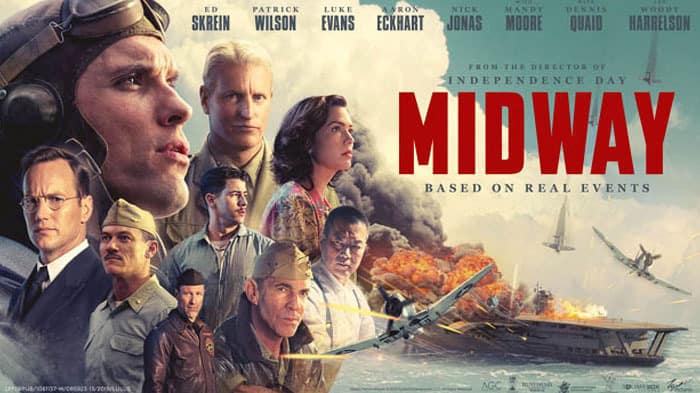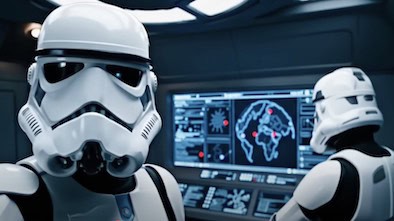Will Rolan Emmerich’s Midway continue the cinematic legacy in the same vein as Michael Bay’s Pearl Harbor? Sam Edwards discusses.

It has been 20 years since the release of Michael Bay’s bombastic Pearl Harbor.
Before 2001, we saw the release of several cinematic takes of the tragedy, some of which were released during the second world war and were seen as wartime propaganda.
Most mainstream audiences probably remember two variations of the tragedy. Pearl Harbor and the recent Midway, which came out in 2019.
The reception from Pearl Harbor has been mostly negative, However, you can’t deny the fact that the film is very memorable for better or worse.
Whether it’s the historical inaccuracies, the thrilling spectacle or the romance scenes that would be later reminiscent in Attack of the Clones, 2 years later.
However, my main area of focus will be the film Midway (2019). The question that remains is whether or not this film carries a similar legacy that Pearl Harbor has established.
In 20 years time, I wonder which of the two will get the bragging rights. Pearl Harbor or Midway. Let’s begin with Midway.

The acclaimed pioneer of grand spectacle, Roland Emmerich. Tells his take on WW2’s biggest turning points, The Battle of Midway.
This being his 20-year passion project, he manages to deliver an exciting cinematic look in a story filled with high stakes and true heroism.
It’s clear that Roland Emmerich has established a niche for popcorn action films, a particular set of skills that not many filmmakers possess, and he does it well.
Several critics have bashed his work, films such as White House Down (2013) and Godzilla (1998), both of which I have an interest for.
In today’s cinema, his main competitor is most likely Michael Bay.
Like Michael Bay, several of his films contain strong themes of American patriotism. Films such as Independence Day (1996) and The Patriot (2000) are both grand pieces of action spectacle but the beating heart of these films is undeniably patriotism.
Therefore, he has an interest in B action films but also adapting true stories to film.
The stories that appeal to him are always the ones that have a strong focus on bravery and courage, both of which are very universal themes.
He likes stories that portray America or any other nation as the underdogs who take on a force of sizable magnitude, whether it’s monsters, robots or even the end of the world in 2012 (2009).
Here, the film starts with a heavy opening of despair and destruction with the bombing of Pearl Harbor.
This puts the audience in a position to root for the US soldiers. All the events that commence after this are instances of America never giving up, which even from a universal standpoint has an appeal not just for American audiences.

In comparison to his earlier work, he has assembled one of his most impressive castings. The cast includes Woody Harrelson, Ed Skrein, Luke Evans, Mandy Moore, and Dennis Quaid.
We also have newcomers, Nick Jonas and Keenan Johnson who both deliver solid performances in their limited screen time. Patrick Wilson is a great addition, who in recent years has come from a strong background in the horror genre in films such as Annabelle Comes Home (2019) and the Netflix release in the tall grass (2019).
However, his performance here is very convincing as he plays the real-life Naval Officer, Edwin Layton who plays a key role in articulating the preparation of the Japanese attacks, through military strategies.
On the emphatic theme of bravery, we see that come through the most with our main character, ‘Dick Best’ played by Ed Skrein. Dick Best led his dive bomb squadron which helped sink the two Japanese aircraft carriers in 1942.
The film shines a bold light on his reputation and his abilities as a pilot, leader and husband. I believe he is the main character of the film and you can tell that Roland Emmerich has an admiration for him.
This is also helped by the writer, Wes Tooke who has no previous cinematic writing experience, this being his first motion picture.
Special effects and action set pieces are both the films main attractions. For the most part, it delivers with soaring colours.
The scope of these scenes is on an impressive level. For each battle sequence, we see the perspective of the Japanese military strategies and you then see how the US prepares and anticipates their next moves.
With a budget of 100 million US dollars, the CGI did not hold up as well as I would have liked. The film occasionally suffers from sequences that feel too visually overstuffed, where there are too many battle elements in the frame. It sometimes disorientates your attention.
Like its predecessor or competitor, Pearl Harbor (2001). That film had more convincing effects.
However, that film did have a budget of 132.2 million US dollars. On the flip side, this film has a very straight forward feel to it. It never diverts from its established themes. Whereas Pearl Harbor (2001) had a romantic focus that proved unfavourable to most audiences, with a rotten tomatoes score of 24%. This film balances the tone very well.
For a runtime of 2 hours and 38 minutes, the film is paced well and moves at a steadily progressive pace, giving a nice balance between important exposition and battle sequences.
The story itself has been done repeatedly, which makes the story frustratingly predictable. Films that have held a similar plot setting have been released since the 1940s with propaganda piece December 7th (1943).

In terms of cinematic releases, films such as Midway (1976) and Michael Bay’s Pearl Harbor (2001) are more dramatizations of real-life events, not tailored for complete accurate portrayal.
The Critical reception for Midway (2019) has been mostly negative, with a rotten tomatoes score of 41% and an average IMDb score of 6.7.
The film grossed 125.6 million dollars worldwide, with many bashing the film’s screenplay. The film is currently showing free on Amazon prime. Although it is best seen on the big screen, I can happily recommend this film.
It took me by surprise by its intense battle sequences. It holds a strong thematic heartbeat throughout, that of courage and bravery.
Afterwards, I became more interested in the military aspect of the pearl harbor attack.
For a runtime of over 2 hours, it flew by and this makes for a good Friday night experience.
The film does have flaws but competently excels in its action.
The distinguishing factor between Pearl Harbor and Midway is the love story.
Pearl Harbor focuses a lot on the romance, whereas Midway is straight to the point.
Do you agree with the review? What is your favourite cinematic depiction of the tragedy?
For more reviews like this click here or visit our homepage.





